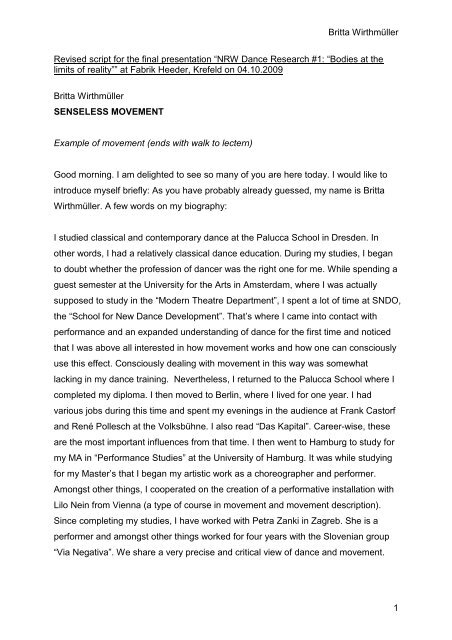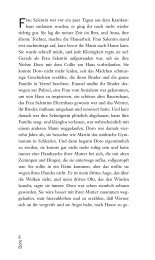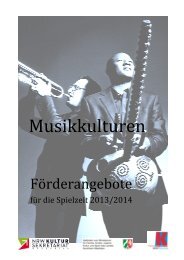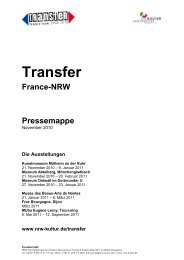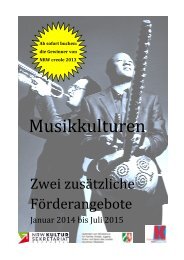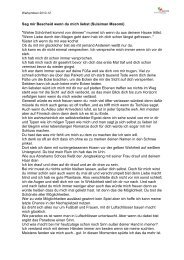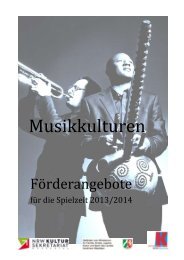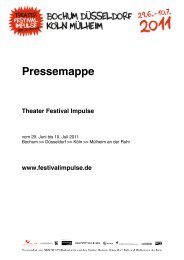Britta Wirthmüller 1 Revised script for the final presentation “NRW ...
Britta Wirthmüller 1 Revised script for the final presentation “NRW ...
Britta Wirthmüller 1 Revised script for the final presentation “NRW ...
You also want an ePaper? Increase the reach of your titles
YUMPU automatically turns print PDFs into web optimized ePapers that Google loves.
<strong>Britta</strong> <strong>Wirthmüller</strong><br />
<strong>Revised</strong> <strong>script</strong> <strong>for</strong> <strong>the</strong> <strong>final</strong> <strong>presentation</strong> <strong>“NRW</strong> Dance Research #1: “Bodies at <strong>the</strong><br />
limits of reality”” at Fabrik Heeder, Krefeld on 04.10.2009<br />
<strong>Britta</strong> <strong>Wirthmüller</strong><br />
SENSELESS MOVEMENT<br />
Example of movement (ends with walk to lectern)<br />
Good morning. I am delighted to see so many of you are here today. I would like to<br />
introduce myself briefly: As you have probably already guessed, my name is <strong>Britta</strong><br />
<strong>Wirthmüller</strong>. A few words on my biography:<br />
I studied classical and contemporary dance at <strong>the</strong> Palucca School in Dresden. In<br />
o<strong>the</strong>r words, I had a relatively classical dance education. During my studies, I began<br />
to doubt whe<strong>the</strong>r <strong>the</strong> profession of dancer was <strong>the</strong> right one <strong>for</strong> me. While spending a<br />
guest semester at <strong>the</strong> University <strong>for</strong> <strong>the</strong> Arts in Amsterdam, where I was actually<br />
supposed to study in <strong>the</strong> “Modern Theatre Department”, I spent a lot of time at SNDO,<br />
<strong>the</strong> “School <strong>for</strong> New Dance Development”. That’s where I came into contact with<br />
per<strong>for</strong>mance and an expanded understanding of dance <strong>for</strong> <strong>the</strong> first time and noticed<br />
that I was above all interested in how movement works and how one can consciously<br />
use this effect. Consciously dealing with movement in this way was somewhat<br />
lacking in my dance training. Never<strong>the</strong>less, I returned to <strong>the</strong> Palucca School where I<br />
completed my diploma. I <strong>the</strong>n moved to Berlin, where I lived <strong>for</strong> one year. I had<br />
various jobs during this time and spent my evenings in <strong>the</strong> audience at Frank Castorf<br />
and René Pollesch at <strong>the</strong> Volksbühne. I also read “Das Kapital”. Career-wise, <strong>the</strong>se<br />
are <strong>the</strong> most important influences from that time. I <strong>the</strong>n went to Hamburg to study <strong>for</strong><br />
my MA in “Per<strong>for</strong>mance Studies” at <strong>the</strong> University of Hamburg. It was while studying<br />
<strong>for</strong> my Master’s that I began my artistic work as a choreographer and per<strong>for</strong>mer.<br />
Amongst o<strong>the</strong>r things, I cooperated on <strong>the</strong> creation of a per<strong>for</strong>mative installation with<br />
Lilo Nein from Vienna (a type of course in movement and movement de<strong>script</strong>ion).<br />
Since completing my studies, I have worked with Petra Zanki in Zagreb. She is a<br />
per<strong>for</strong>mer and amongst o<strong>the</strong>r things worked <strong>for</strong> four years with <strong>the</strong> Slovenian group<br />
“Via Negativa”. We share a very precise and critical view of dance and movement.<br />
1
<strong>Britta</strong> <strong>Wirthmüller</strong><br />
My research project was conducted under <strong>the</strong> title “Bodies at <strong>the</strong> limits of reality”. I<br />
will explain later on in more depth what I understand by “limits of reality”. However, I<br />
have given this morning’s <strong>presentation</strong> <strong>the</strong> title “Senseless Movement” – and I’ll come<br />
back to that in a while as well.<br />
In <strong>the</strong> eight weeks that I was a guest of Fabrik Heeder here in Krefeld, I was<br />
preoccupied with <strong>the</strong> question of what is not visible, cannot be presented or is not to<br />
be named with regard to <strong>the</strong> human body. When I talk about <strong>the</strong> body from now on,<br />
<strong>the</strong>n I’m always referring to our own body, to <strong>the</strong> extent that we are all bodies<br />
(starting from <strong>the</strong> very tangible things such as bones, organs, muscles and nerve<br />
cells through to our psyche and our self-awareness). What I mean by this is that<br />
while we frequently talk about ‘our body’, we ultimately identify ourselves as this body.<br />
When I look at my body in a photograph, I don’t say: “That’s my body,” instead I say:<br />
“That’s me.”<br />
There are some things we can all perceive about our bodies (pain, movement,<br />
hunger, thirst, feelings of numbness) and on <strong>the</strong> o<strong>the</strong>r hand those that we might<br />
perceive, but cannot name or define, or which we find difficult to put a finger on. We<br />
can sense that <strong>the</strong>y are <strong>the</strong>re, but we can find no language or expression <strong>for</strong> <strong>the</strong>m.<br />
Now, <strong>the</strong>re is a whole string of philosophical concepts that revolve around <strong>the</strong>se<br />
invisible things. For Jacques Lacan it is <strong>the</strong> term of <strong>the</strong> “real”, <strong>for</strong> Martin Heidegger<br />
and Jean-Paul Sartre “nothingness”, <strong>for</strong> Friedrich Nietzsche “chaos”. However, my<br />
research is not (spiritually) scientific, but artistic; I would <strong>the</strong>re<strong>for</strong>e like to restrict<br />
myself to this area, having tried (without knowing what it looked like) to describe that<br />
which is simply inconceivable. Whatever this is appears nei<strong>the</strong>r positive or negative,<br />
it is nei<strong>the</strong>r perceived nor missed.<br />
It is difficult to give an example of this. It is easier <strong>for</strong> me to give a negative example:<br />
One could say that <strong>the</strong> taboo falls in that sought-after realm, but <strong>the</strong> taboo knows<br />
what it represents. 1 It <strong>the</strong>re<strong>for</strong>e names what cannot be. However, what I have sought<br />
<strong>for</strong> is that which does not even cross our minds to think about and <strong>for</strong> which <strong>the</strong>re can<br />
be no name.<br />
1 I would like to thank Dr. Christian Grüny <strong>for</strong> this idea and <strong>for</strong>mulation.<br />
2
<strong>Britta</strong> <strong>Wirthmüller</strong><br />
What is important now in order to artistically approach my research question, is that<br />
an answer to this question can only ever have one reference: “The visualisation of a<br />
limit” 2 , to use <strong>the</strong> words of <strong>the</strong> philosopher Marcus Steinweg. If <strong>the</strong> realm I have<br />
searched <strong>for</strong> cannot be named, <strong>the</strong>n I will not be able to give it a name even through<br />
artistic work. I can <strong>the</strong>re<strong>for</strong>e only succeed in referring to it, <strong>for</strong> example by making a<br />
limit visible, which demarcates something known from something else. This o<strong>the</strong>r<br />
thing is <strong>the</strong> sought-after realm, of which we know nothing and which we cannot see,<br />
of which all we know that it has to be <strong>the</strong>re because we come up against a limit,<br />
behind which something else begins.<br />
In <strong>the</strong> rest of my <strong>presentation</strong>, I will provide you with an insight into how I proceeded<br />
with my research.<br />
DISCUSSION PARTNERS<br />
In <strong>the</strong> first two to three weeks of my research, I met people in NRW who I expected<br />
would frequently encounter or had encountered this “limit of reality”, based on <strong>the</strong>ir<br />
profession or personal experience. These discussion partners included philosophers,<br />
neurologists, a teacher of <strong>the</strong> Alexander Technique, an osteopath, a pregnant<br />
woman and a dancer with many years of professional experience. What interested<br />
me about this highly abstract research question was whe<strong>the</strong>r and where this sought-<br />
after realm occurred in reality. Interestingly, all discussion partners found my question<br />
about <strong>the</strong> invisible aspects of <strong>the</strong> body an important one. I made notes of <strong>the</strong>se<br />
discussions. What you can see here<br />
Point to poster<br />
is a type of mind map <strong>for</strong> <strong>the</strong> “limit of reality”. It contains ideas, questions, terms and<br />
propositions of my discussion partners and of myself, arranged in loose categories.<br />
PRACTICAL RESEARCH<br />
2 Steinweg, Marcus: “Definition der Kunst”, in Huber, Tobias/Steinweg, Marcus (Hg): “Theses on<br />
Contemporary Art”, Zurich/Berlin: diaphanes 2008, p. 126<br />
3
<strong>Britta</strong> <strong>Wirthmüller</strong><br />
In addition to <strong>the</strong>se discussions, I also tried to experience <strong>the</strong> “limit of reality” in my<br />
own body. I came across a book in which <strong>the</strong> British neurophysiologist Jonathan Cole<br />
tells <strong>the</strong> story of his patient and friend Ian Waterman. The book is called “Pride and a<br />
Daily Marathon” 3 . Ian Waterman fell ill with a harmless virus infection at <strong>the</strong> age of 19.<br />
However – as one suspects – his immune system destroyed large parts of his<br />
sensory nervous system during his recovery. Within <strong>the</strong> peripheral nervous system, a<br />
distinction is made between <strong>the</strong> motor nervous system, which is responsible <strong>for</strong><br />
muscle control, and <strong>the</strong> sensory nervous system, which is responsible <strong>for</strong> <strong>the</strong><br />
perception of skin, pain, temperature and joint position. A failure of <strong>the</strong> sensory<br />
nervous system leads to <strong>the</strong> loss of proprioception, i.e. <strong>the</strong> sense that enables us to<br />
perceive <strong>the</strong> position, state and movement of <strong>the</strong> body in space. Normally, we are<br />
unaware of this sense. We also constantly receive in<strong>for</strong>mation from <strong>the</strong> sensory<br />
nervous system. For example, as you sit here this morning in <strong>the</strong> audience, your<br />
sensory nervous system is giving you in<strong>for</strong>mation about <strong>the</strong> angle of your elbow,<br />
whe<strong>the</strong>r your feet are touching <strong>the</strong> floor or – if you have crossed your legs – how <strong>the</strong><br />
back of your right thigh is lying on <strong>the</strong> front of your left thigh. All this happens without<br />
you having to concentrate on it.<br />
Normally, failures in <strong>the</strong> motor and sensory nervous systems go hand in hand. Ian<br />
Waterman is one of <strong>the</strong> few cases in which only <strong>the</strong> sensory nervous system was<br />
affected.<br />
We can see how essential <strong>the</strong> sensory nervous system is because Ian Waterman<br />
was no longer able to walk or sit within just a few days of being infected with <strong>the</strong> virus.<br />
Although he possessed full muscle power, he was no longer able to use it<br />
meaningfully. He even described lying in bed as a deeply unsettling situation,<br />
because without feedback on <strong>the</strong> location and position of his body, he had <strong>the</strong> feeling<br />
he was floating.<br />
Ian Waterman fell ill at <strong>the</strong> beginning of <strong>the</strong> 1960s. His doctors did not know of any<br />
<strong>the</strong>rapy. They assumed that Waterman would have to spend <strong>the</strong> rest of his life in a<br />
wheelchair. However, Waterman decided to work against this prognosis. On his own<br />
initiative, he gradually learned to use his sense of vision in order to move around.<br />
3 Cole, Jonathan O.: “Pride and a daily marathon”, London: MIT Press 1995<br />
4
<strong>Britta</strong> <strong>Wirthmüller</strong><br />
This only happened very slowly and with maximum concentration he could only move<br />
what he saw.<br />
Although Ian Waterman never regained his proprioception, he learnt to use his body<br />
in such a way that he was able to lead a self-determined life. Through <strong>the</strong> loss of a<br />
sense which we are not normally even aware of, Ian Waterman was <strong>for</strong>ced to use his<br />
body in a way that he and his doctors did not know was even possible. Interestingly,<br />
Ian Waterman lacked both <strong>the</strong> words to describe what he lacked and also what he<br />
was now doing to compensate <strong>for</strong> this defect. Here, we are <strong>the</strong>re<strong>for</strong>e dealing with a<br />
double “limit of reality” at once: The loss of something we did not know we had (<strong>the</strong><br />
proprioception) and <strong>the</strong> replacement of this loss, which lacks an accurate de<strong>script</strong>ion.<br />
I knew that it would be impossible to recreate Ian Waterman’s experience in my own<br />
body. However, a simple and harmless approximation was a transposition of our<br />
right/left preferences. As a right-handed person, I spent 72 hours doing everything I<br />
normally do with my right hand with my left hand and vice versa.<br />
Video: Eating left-handed<br />
What interested my in all of this was how I can make normally automatic and<br />
apparently simple movements conscious in <strong>the</strong>ir complexity. In many instances it was<br />
relatively easy to do things with <strong>the</strong> o<strong>the</strong>r hand after a short while. In a few of <strong>the</strong>m I<br />
noticed how differently expressed <strong>the</strong> sensory abilities are on <strong>the</strong> two hands (at least<br />
<strong>for</strong> right-handers). Brushing one’s teeth, like writing <strong>for</strong> example, is a highly complex<br />
process which I can only per<strong>for</strong>m inadequately with my left hand. Similarly <strong>the</strong> tying<br />
of shoelaces. Having though about it <strong>for</strong> a while, it is entirely possible <strong>for</strong> me to tie a<br />
lace with my left hand. However, <strong>the</strong> experience is amazingly unusual, as if one has<br />
discovered something completely new that never existed be<strong>for</strong>e.<br />
As you have seen, <strong>the</strong> movements appear awkward and tense. I attempt to offset <strong>the</strong><br />
lack of coordination through unnecessary use of <strong>for</strong>ce. For <strong>the</strong> observer, something<br />
about <strong>the</strong>se very everyday movements appears irritating. However, this irritation did<br />
not go far enough <strong>for</strong> me.<br />
5
GRIP BEHAVIOUR<br />
<strong>Britta</strong> <strong>Wirthmüller</strong><br />
Apart from self-perception, I was interested in how I can refer to <strong>the</strong> “limit of reality”<br />
directly in <strong>the</strong> observer. In this regard, I was interested in <strong>the</strong> so-called “grip<br />
behaviour”. This term comes from <strong>the</strong> field of neurology. Instead of spending a long<br />
time explaining it, I will demonstrate it briefly.<br />
Cup and glass on a table at <strong>the</strong> front of <strong>the</strong> stage<br />
If this glass is here and I hold my hand like this (close to <strong>the</strong> cup with opened ‘ready-<br />
to-grip’ fingers), what would you say I am doing? You would say I am about to grip<br />
<strong>the</strong> glass. If this cup is standing next to <strong>the</strong> glass and I hold my hand like this (<strong>the</strong><br />
same position as above), you will still say that I am going to grip <strong>the</strong> glass. As long as<br />
you recognise <strong>the</strong> object and my hand position, you will be able to predict what I am<br />
going to grip. This knowledge is experiential knowledge. You know what it means to<br />
grip a glass, <strong>the</strong>re<strong>for</strong>e this scenario of this specific hand position is enough <strong>for</strong> you to<br />
anticipate <strong>the</strong> grip behaviour in your imagination. The motor system <strong>the</strong>re<strong>for</strong>e does<br />
not recognise individual movements, but actions such as: gripping and lifting, gripping<br />
and moving to <strong>the</strong> mouth.<br />
You probably did not have to think very long about what I would pick up. You might<br />
even say that you did not have to think about it all. (Whe<strong>the</strong>r that is true depends on<br />
our definition of thinking). The fact, <strong>the</strong>re<strong>for</strong>e, is that our brain predicts what is going<br />
to happen incredibly quickly.<br />
In this expectation, which is also common to us <strong>for</strong> everyday objects in a specific<br />
cultural area, I saw <strong>the</strong> potential to discover ano<strong>the</strong>r “limit of reality”.<br />
Video: Gripping objects (a row of everyday objects such as a cup, hat, broom and<br />
book are distributed on podiums of different heights in <strong>the</strong> vicinity of <strong>the</strong><br />
demonstrating person. The person approaches <strong>the</strong> individual objects as if to pick<br />
<strong>the</strong>m up, but at <strong>the</strong> last moment diverts <strong>the</strong> movement to apparently pick up ano<strong>the</strong>r<br />
object. In doing so, <strong>the</strong> grip position of <strong>the</strong> hand alters.)<br />
6
<strong>Britta</strong> <strong>Wirthmüller</strong><br />
This was <strong>the</strong> attempt to initiate grip behaviour using a row of everyday objects, but<br />
never to carry it out. If it is right what neurologists say, <strong>the</strong>n expectation and<br />
observation must deviate from each o<strong>the</strong>r in our brain and at least lead to a brief<br />
period of confusion. This confusion could point to expectations of which we know<br />
absolutely nothing. This goes hand in hand with <strong>the</strong> assertion of many neurologists<br />
that in actual fact we consciously decide extremely little of what we believe we<br />
consciously decide.<br />
What interested me here in terms of my artistic work is <strong>the</strong> question of whe<strong>the</strong>r I can<br />
develop a <strong>for</strong>m of dance that demands a purely motor-based style of interpretation,<br />
beyond any symbolism and linguistic interpretation. Firstly: what do I mean by<br />
symbolic interpretation? When we look at something, we almost always have <strong>the</strong><br />
need to make sense of this observation. Something similar happens when we watch<br />
a piece of dance. We want to know what it is about. In a danced duet, or even easier<br />
in a pas de deux in ballet, that is simple. It is obviously about a relationship between<br />
people: love, attraction, rejection, hate, etc. Whatever we see, we interpret with our<br />
senses. This interpretation always functions via <strong>the</strong> word, i.e. via language, even if<br />
we perhaps do not vocalise it or write it down. I am claiming that <strong>the</strong>re is a much<br />
more direct way of understanding movement prior to <strong>the</strong> interpretation (at which we<br />
more or less consciously arrive). And by ‘understand’ I do not mean any rational<br />
cognitive process, but <strong>the</strong> simple fact that you follow and comprehend <strong>the</strong> movement.<br />
In o<strong>the</strong>r words, an implicit, originally pragmatic and non-reflexive <strong>for</strong>m of<br />
understanding.<br />
When I reach out my hand to this glass, that is a meaningful movement <strong>for</strong> you,<br />
which you understand <strong>for</strong> <strong>the</strong> simple reason that you yourself have reached out your<br />
hand to a glass a thousand times. Now, you can of course ask why I am gripping <strong>the</strong><br />
glass, but you can only ask this question because you ‘understand’ <strong>the</strong> act <strong>for</strong> what it<br />
is. If I were currently standing on stage, you might also have <strong>the</strong> need to understand<br />
what you are seeing on a symbolic level. However, this is always preceded by <strong>the</strong><br />
motor understanding.<br />
7
<strong>Britta</strong> <strong>Wirthmüller</strong><br />
I have <strong>the</strong>re<strong>for</strong>e tried to generate movements that above all trigger this motor<br />
understanding. However, this proved extremely difficult <strong>for</strong> <strong>the</strong> stage, because we<br />
apparently tend to view everything that happens on stage as something symbolic.<br />
TRANSFER TO THE BODY<br />
Following on from my research in Krefeld, I enhanced <strong>the</strong> approaches already<br />
described with my colleague Petra Zanki in Zagreb. We transferred <strong>the</strong> principle of<br />
<strong>the</strong> ‘desire to grip objects’ to movements without objects. It now concerned not only<br />
making <strong>the</strong> same movement without an object, but about finding movements which –<br />
like <strong>the</strong>se grip behaviours – are known to us as logical movements. For all <strong>the</strong>ir<br />
difference, our bodies follow certain principles, which are so everyday that we hardly<br />
notice <strong>the</strong>m.<br />
Slide; The “normal” body<br />
The head is at <strong>the</strong> top.<br />
The feet are at <strong>the</strong> bottom.<br />
We move in <strong>the</strong> direction in which <strong>the</strong> eyes are looking.<br />
We place our heels down first when walking.<br />
We brea<strong>the</strong> in and out.<br />
We grip things that are to <strong>the</strong> left of our body with our left hand.<br />
We grip things that are to <strong>the</strong> right of our body with our right hand.<br />
We lift <strong>the</strong> foot that we want to take a step with.<br />
We may know how a body moves normally, but we are far from knowing how it has to<br />
move in order to have a different effect on us. Some principles could be circumvented;<br />
however this would correspond to <strong>the</strong> taboo that already knows what it represents.<br />
The only option <strong>the</strong>re<strong>for</strong>e is to point to <strong>the</strong> unfamiliar in <strong>the</strong> familiar. We have thus<br />
worked with movements that everyone knows, such as a jump.<br />
Jump to <strong>the</strong> right<br />
8
<strong>Britta</strong> <strong>Wirthmüller</strong><br />
Most of you will have suspected that I would jump and you will even probably have<br />
known that <strong>the</strong> jump would be to <strong>the</strong> right. It is <strong>the</strong>re<strong>for</strong>e enough <strong>for</strong> me to do this<br />
Bend knee <strong>for</strong> jump to <strong>the</strong> right<br />
<strong>for</strong> you to imagine a jump to <strong>the</strong> right. But what if I do not jump at all or only jump a<br />
little or cancel my own intention? Then this happens<br />
(...)<br />
A movement which you had not <strong>for</strong>eseen and which I had not planned that way, nor<br />
was I able to fully guess its outcome. It is a meaningless movement because it does<br />
not make any sense in our experience of movement. It has no clear direction, it is not<br />
efficient – on <strong>the</strong> contrary, it wastes energy, but without an admirable effect. One<br />
could say it is inorganic, even though an organism produced it.<br />
Right at <strong>the</strong> beginning, I showed you a sequence of movements that was also a<br />
meaningless phrase of movement in this context. I deliberately showed it to you right<br />
at <strong>the</strong> beginning so that you could watch it without this in<strong>for</strong>mation at <strong>the</strong> back of your<br />
mind. I would not like to speculate fur<strong>the</strong>r on whe<strong>the</strong>r this movement is actually<br />
meaningless or whe<strong>the</strong>r it does not make sense again out of its meaninglessness.<br />
Perhaps we can address this question and any o<strong>the</strong>rs in a discussion afterwards.<br />
Thank you <strong>for</strong> your attention.<br />
9


